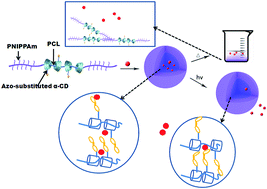The preparation of an azo-substituted polyrotaxane end-capped with PNIPPAAm and its dual stimuli-responsive behavior for drug delivery applications
Abstract
A polyrotaxane-containing triblock copolymer (PRTBP) was synthesized via ATRP of NIPPAAm initiated by the self-assembly of α-cyclodextrins (α-CDs) with distal 2-bromopropionyl end-capped poly(caprolactone) (Br–PCL–Br) in water at 25 °C. After that, an azobenzene group was introduced into the polyrotaxane block via the hydroxyl of threaded α-CD to get azo-substituted PRTBP (APRTBP). The structure was characterized in detail by 1H NMR, FTIR and WXRD techniques. Its thermal and light responsive properties were demonstrated by turbidity measurements and UV spectroscopy, respectively. Furthermore, micelles with diameters of around 100 nm were prepared from APRTBP in aqueous solution. Dynamic laser scattering (DLS) measurements demonstrated that the micelles contracted under UV irradiation and successively expanded under visible light, which offers a reversible on–off switch for controlling the drug release behavior of micelles. Consequently, the in vitro drug release curve, which is similar to the pharmacokinetic curve of multiple dosing administrations, was achieved when UV and visible light were applied alternatively to simulate on–off states for drug release. It also showed that the micelle possessed a significantly higher release rate and higher cumulative release amount under UV irradiation than those under visible light. Furthermore, the low critical solution temperature (LCST) of NIPPAAm blocks in APRTBP can be used as another switch to trigger the drug release as implied by in vitro drug release tests using doxorubicin (DOX) as the model drug. Considering its interesting dual stimuli-responsiveness and on–off switch-like behaviors resulting from dual responsiveness, APRTBP shows considerable potential as a candidate for controlled drug delivery systems and other possible biomedical applications.

- This article is part of the themed collection: 2014 Journal of Materials Chemistry B Hot Articles

 Please wait while we load your content...
Please wait while we load your content...